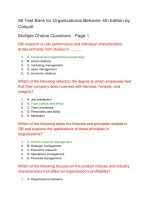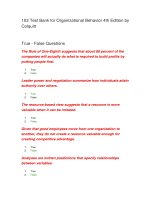Organizational behavior 4th by MShean chap008
Bạn đang xem bản rút gọn của tài liệu. Xem và tải ngay bản đầy đủ của tài liệu tại đây (422.34 KB, 32 trang )
8
Decision Making and Creativity
McGraw-Hill/Irwin
© 2008 The McGraw-Hill Companies, Inc. All rights reserved.
Decision Making at Radical
Ron Sangha/ BC Business
Radical Entertainment founder Ian Wilkinson (third from
right) meets with employees every week to reinforce the
electronic games developer’s emphasis on creative
decision making and employee involvement.
McShane/Von Glinow OB4e
Slide 8-2
© 2008 The McGraw-Hill Companies, Inc. All rights reserved.
Decision Making Defined
Ron Sangha/ BC Business
Decision making is a conscious process of
making choices among one or more alternatives
with the intention of moving toward some desired
state of affairs.
McShane/Von Glinow OB4e
Slide 8-3
© 2008 The McGraw-Hill Companies, Inc. All rights reserved.
Rational Choice Decision Process
McShane/Von Glinow OB4e
Slide 8-4
© 2008 The McGraw-Hill Companies, Inc. All rights reserved.
Problem Identification Process
• Problems and opportunities are not announced or
pre-defined
– need to interpret ambiguous information
• Problem identification uses both logical analysis and
unconscious emotional reaction during perceptual
process
– need to pay attention to both logic and emotional
reaction in problem identification
McShane/Von Glinow OB4e
Slide 8-5
© 2008 The McGraw-Hill Companies, Inc. All rights reserved.
Famous Missed Opportunities
The top-rated television
commercial in history -- the Apple
Macintosh “Why 1984 won’t be like
1984” -- almost wasn’t aired
because every outside director on
Apple’s board despised it. The ad
violated the mental models that
they held of what a good ad should
look like.
Apple Computer Inc. Used with permission
McShane/Von Glinow OB4e
Slide 8-6
© 2008 The McGraw-Hill Companies, Inc. All rights reserved.
Problem Identification Challenges
1. Stakeholder framing
2. Perceptual defense
3. Mental models
4. Decisive leadership
5. Solution-focused
problems
Apple Computer Inc. Used with permission
McShane/Von Glinow OB4e
Slide 8-7
© 2008 The McGraw-Hill Companies, Inc. All rights reserved.
Identifying Problems Effectively
• Be aware of perceptual and
diagnostic limitations
• Understand mental models
• Discussing the situation with
colleagues -- see different
perspectives
Apple Computer Inc. Used with permission
McShane/Von Glinow OB4e
Slide 8-8
© 2008 The McGraw-Hill Companies, Inc. All rights reserved.
Making Choices: Rational vs OB Views
Goals
Rational: Clear, compatible, agreed upon
OB: Ambiguous, conflicting, lack agreement
Processing
Information
Rational: People can process all information
OB: People process only limited information
Evaluation
Timing
Rational: Choices evaluated simultaneously
OB: Choices evaluated sequentially
more
McShane/Von Glinow OB4e
Slide 8-9
© 2008 The McGraw-Hill Companies, Inc. All rights reserved.
Making Choices: Rational vs OB (con’t)
Standards
Rational: Evaluate against absolute standards
OB: Evaluate against implicit favorite
Info Quality
Rational: People rely on factual information
OB: Rely on perceptually distorted information
Decision
Objective
Rational: Maximization -- the optimal choice
OB: Satisficing -- a “good enough” choice
McShane/Von Glinow OB4e
Slide 8-10
© 2008 The McGraw-Hill Companies, Inc. All rights reserved.
Emotions and Making Choices
1. Emotional marker process forms preferences before
we consciously think about choices
2. Moods and emotions influence the decision process
• affects vigilance, risk aversion, etc.
3. We ‘listen in’ on our emotions and use that information
to make our choices
McShane/Von Glinow OB4e
Slide 8-11
© 2008 The McGraw-Hill Companies, Inc. All rights reserved.
Intuitive Decision Making
• Ability to know when a problem or opportunity exists and
select the best course of action without conscious
reasoning
• Intuition as emotional experience
– Gut feelings are emotional signals
– Not all emotional signals are intuition
• Intuition as rapid unconscious analysis
– Uses action scripts
McShane/Von Glinow OB4e
Slide 8-12
© 2008 The McGraw-Hill Companies, Inc. All rights reserved.
Making Choices more Effectively
• Systematically evaluate alternatives
• Balance emotions and rational influences
• Scenario planning
McShane/Von Glinow OB4e
Slide 8-13
© 2008 The McGraw-Hill Companies, Inc. All rights reserved.
Escalation of Commitment
• Escalation of commitment
occurred when the British
government continued funding
the Concorde supersonic jet
long after it’s lack of
commercial viability was
apparent. Some scholars refer
to escalation of commitment
as the “Concorde fallacy.”
© Corel Corp. With permission
McShane/Von Glinow OB4e
Slide 8-14
© 2008 The McGraw-Hill Companies, Inc. All rights reserved.
Escalation of Commitment Causes
1. Self-justification
2. Prospect theory effect
3. Perceptual blinders
4. Closing costs
© Corel Corp. With permission
McShane/Von Glinow OB4e
Slide 8-15
© 2008 The McGraw-Hill Companies, Inc. All rights reserved.
Evaluating Decisions Better
1. Separate decision choosers from evaluators
2. Establish a preset level to abandon the project
3. Involve several people in the evaluation process
McShane/Von Glinow OB4e
Slide 8-16
© 2008 The McGraw-Hill Companies, Inc. All rights reserved.
Employee Involvement Defined
The degree to which employees influence how
their work is organized and carried out
– Level of control over decision making
– Different levels and forms of involvement
McShane/Von Glinow OB4e
Slide 8-17
© 2008 The McGraw-Hill Companies, Inc. All rights reserved.
Employee Involvement Model
Potential Involvement
Outcomes
• Better problem
identification
Employee
Involvement
• More/better solutions
generated
Contingencies
of Involvement
McShane/Von Glinow OB4e
Slide 8-18
• Best choice more
likely
• Higher decision
commitment
© 2008 The McGraw-Hill Companies, Inc. All rights reserved.
Contingencies of Involvement
Higher employee involvement is better when:
Decision
Structure
Knowledge
Source
Decision
Commitment
Risk of
Conflict
McShane/Von Glinow OB4e
• Problem is new & complex
(i.e nonprogrammed decision)
• Employees have relevant knowledge
beyond leader
• Employees would lack commitment
unless involved
• Norms support firm’s goals
• Employee agreement likely
Slide 8-19
© 2008 The McGraw-Hill Companies, Inc. All rights reserved.
Creative Process Model
Verification
Insight
Incubation
Preparation
McShane/Von Glinow OB4e
Slide 8-20
© 2008 The McGraw-Hill Companies, Inc. All rights reserved.
Characteristics of Creative People
• Above average intelligence
• Persistence
• Relevant knowledge and experience
• Inventive thinking style
McShane/Von Glinow OB4e
Slide 8-21
© 2008 The McGraw-Hill Companies, Inc. All rights reserved.
Creative Work Environments
• Learning orientation
– Encourage experimentation
– Tolerate mistakes
• Intrinsically motivating work
– Task significance, autonomy, feedback
• Open communication and sufficient resources
• Team competition and time pressure have complex
effect on creativity
McShane/Von Glinow OB4e
Slide 8-22
© 2008 The McGraw-Hill Companies, Inc. All rights reserved.
Creative Activities
Redefine
the Problem
Associative
Play
CrossPollination
• Review
abandoned
projects
• Storytelling
• Diverse teams
• Artistic activities
• Explore issue
with other
people
• Morphological
analysis
• Information
sessions
McShane/Von Glinow OB4e
Slide 8-23
• Internal
tradeshows
© 2008 The McGraw-Hill Companies, Inc. All rights reserved.
8
Decision Making and Creativity
McGraw-Hill/Irwin
© 2008 The McGraw-Hill Companies, Inc. All rights reserved.
8
Solutions to Creativity
Brainbusters
McGraw-Hill/Irwin
© 2008 The McGraw-Hill Companies, Inc. All rights reserved.









